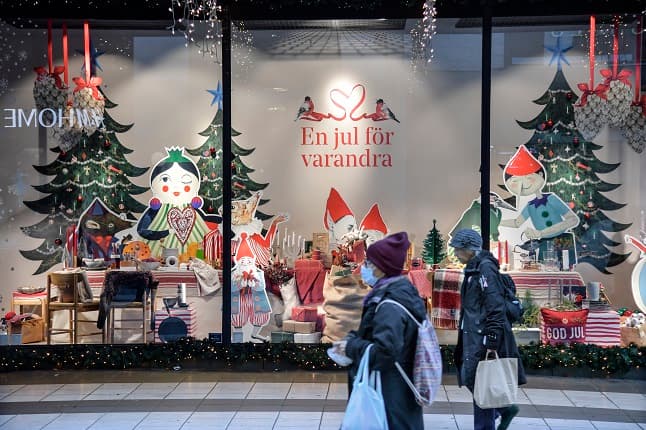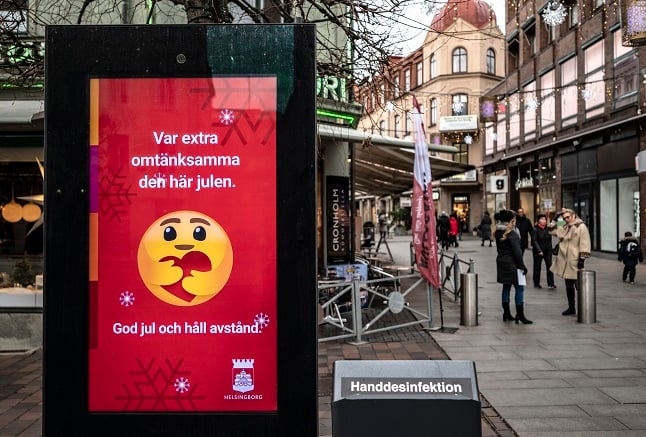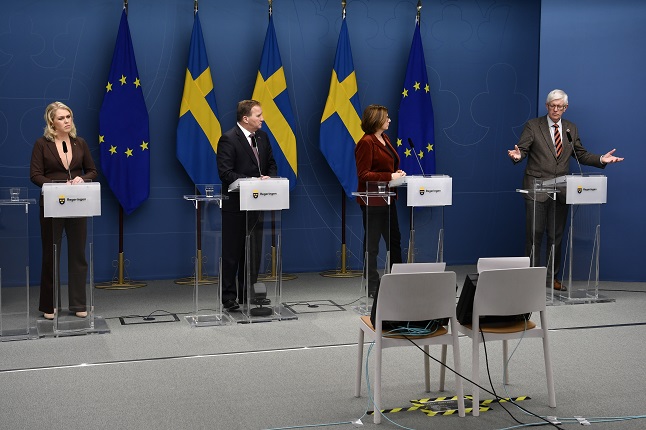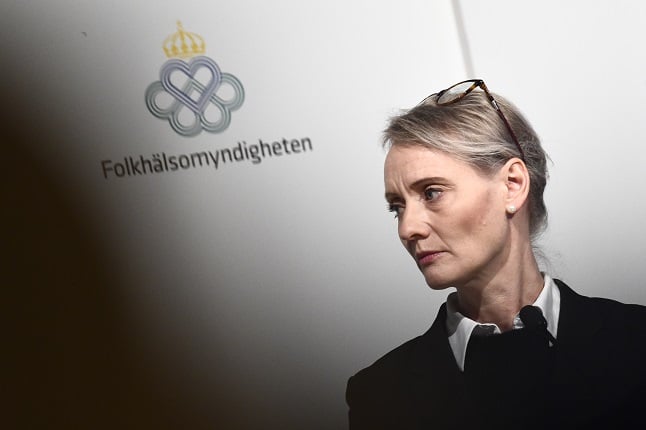Q&A: What do you need to know about Sweden's new coronavirus measures?

UPDATED: This year the festive season will not be like others, with the Swedish government and Public Health Agency urging people in Sweden to meet as few people as possible over the Christmas period.
A new set of national recommendations comes into effect on December 14th, replacing previous regional measures.
"Christmas is a time where we want to be together, but this year we cannot have a normal Christmas," said Prime Minister Stefan Löfven, at a press conference where the new national recommendations were announced.
Health Minister Lena Hallengren summarised the recommendations as follows: Every individual is responsible for taking measures to reduce the spread of Covid-19; keep a distance from others; stay at home if you are sick.
The other key message from the government was to limit all gatherings to as few people as possible, and a maximum of eight people. These should be your closest friends and family, and you should limit new contacts and stick to the same group of no more than eight as much as possible. One big reason for this is that the available data shows homes are the biggest risk environment for spreading coronavirus, followed by social gatherings in crowded indoor environments.
Löfven said: "Celebrate Christmas with a small circle of people. Eight people is the norm for all social situations. Avoid new contacts, meet for a short time, keep a distance, meet outside, avoid shops, trains and buses."
For essential trips to the shops, everyone is asked to shop alone as far as possible, rather than with friends or family members, and in all public places you should continue to keep a distance from other people and avoid busy times as much as you can.
How is this different from the previous recommendations?
The local recommendations, which varied slightly, have been replaced with these new national restrictions. Part of the reason is that people typically travel within Sweden for Christmas, so the slight variations would have been confusing. It should also allow authorities to give clearer communication to the whole population.
There is not much difference in the substance of the recommendations. Everyone in Sweden has been advised to limit their use of public transport, avoid large gatherings, keep a distance from others in public, for several months.
The big change is the government's reiteration of the norm of eight, which has likely become a more important part of the guidelines as the festive period usually sees families and friends gathering.
Under the local recommendations, people were told to socialise only with people they lived with if possible, so the new guidelines might seem less strict. However, the key message is to meet as few people as possible, which might be the people you live with, or a very small number of close friends or family. If you are able to limit socialising to fewer than eight people, you should not look for extra people to invite so that you reach eight.

A sign in Helsingborg says 'be extra considerate this Christmas'. Photo: Johan Nilsson/TT
Who can I meet?
The general director of the Public Health Agency, Johan Carlson, warned people to "stay in your bubble", referring to a small number of close contacts consisting of close family or friends.
You should also avoid being part of multiple bubbles. This means you should speak to the people who are in your bubble to make sure that the total number of contacts is as low as possible, and so that everyone can make a risk assessment.
It also means you should not, for example, meet one group of seven close friends or family for Christmas and a different group of seven on New Year's Eve, the agency clarified to The Local. If you are travelling to visit relatives for Christmas, that's your bubble, and you should avoid meeting other friends a few days later, even if you have previously been meeting them.
While the government has stressed an upper limit of eight, the Public Health Agency's guidelines state: "A small circle is a small number of people, but it is not possible to state an exact number. Who and how many people are included depends on the individual's life circumstances. For some it might be a few close friends, for others their closest family."
Are children included in the 'eight'?
Yes. We asked the Public Health Agency for clarification on this and were told: "The maximum number of eight people, adults and children, is described by Stefan Löfven as 'the new norm for all social situations, including Christmas and New Year celebrations'."
But again, eight isn't a legal limit, so there is room to use your own judgment. For example if your close circle includes two households of five people each, it does not make sense to exclude two individuals, though you could consider keeping each household separate depending on factors like the risk level of household members.
What about elderly relatives?
Age is a key factor in someone's risk of getting seriously ill of Covid-19.
If you want to visit a relative in a care home, you should first check if there is a local visitor ban in place. If there isn't, you should let the care home know in advance, find out their routines for reducing infection risk during visits, and follow the recommendations carefully.
Johan Carlson said that if you will be visiting an elderly relative, you should follow recommendations extra carefully for ten to 14 days before travelling to reduce your risk of catching the coronavirus and passing it to them. He emphasised that if you travel to meet an elderly relative, you should make sure not to go out shopping, meet other people or go to places where you would be around lots of other people.
He urged people to make their own risk assessments, bearing in mind that it is almost impossible to completely remove the risk. For example, rather than several siblings and their families travelling to meet a grandparent, it would be safer for fewer people to meet them. Gatherings could be held outside if possible, or in well-ventilated rooms where it is possible to keep a distance and for a shorter time than usual.
-
Readers reveal: These are the coronavirus measures we'd like to see in Sweden
-
'A lost cause': How the pandemic has disrupted Christmas for Sweden's foreign residents
What about glögg parties/advent fika/Christmas drinks?
The recommendations are not legally enforced so that individuals can adapt them to their personal circumstances. This might make it difficult to know where to draw the line, or how to react if you are invited to an event that would mean bending the guidelines.
Here's what Stockholm's head of healthcare Björn Eriksson has said: " It cannot be worth [risking increased illness and deaths] to have after-work drinks, to socialise outside your own household, crowding to do Christmas shopping, meeting for advent fika even if it's what we want to do. The consequences are awful. Every parent, talk with your children.
"Help out by not only saying 'no' if you get an invitation to socialise outside your household, but also inform the person who invited you that it is a bad idea to have this kind of event at all. We need more people to understand that having a beer after work with some colleagues can have disastrous consequences. I know that many are working patiently to follow the guidelines and recommendations. But now we have to ensure that it is not only 'many', but everyone, who follows the recommendations."
What if my work requires me to come into contact with people outside my bubble over Christmas?
We put this question to the Public Health Agency, and received the answer: "There is no special advice – but the new guidelines put great emphasis on each persons' individual responsibility to follow our guidelines, to avoid close contact with people and so on."
This might mean you choose not to meet relatives in risk groups over Christmas if you aren't able to isolate first, and call them instead. Or it could mean paying extra attention to things like distancing and ventilation if you meet others.
 Left to right: Health and Social Affairs Minister Lena Hallengren, Prime Minister Stefan Löfven, Deputy Prime Minister Isabella Lövin, Public Health Agency General Director Johan Carlson. Photo: Henrik Montgomery/TT
Left to right: Health and Social Affairs Minister Lena Hallengren, Prime Minister Stefan Löfven, Deputy Prime Minister Isabella Lövin, Public Health Agency General Director Johan Carlson. Photo: Henrik Montgomery/TT
Can I travel?
Yes, there is no limit on how far you can travel within Sweden if you are symptom-free, but you should do it in a safe way.
Here is what the Public Health Agency says: "Any travel should take place in a way that minimises the risk of spreading the infection. Remember to limit public transport as much as possible. Avoid making new contacts during the trip and at the destination, beyond the smaller circle that you socialise with [your bubble of no more than eight].
"You should also ensure that you can isolate yourself or get home in an infection-proof way if you develop symptoms of Covid-19.
"Plan your trip so that you can choose a seat reservation, choose other means of travel than public transport and public transport where a seat ticket is not offered. In the first instance, you should choose other ways of travelling yourself, such as walking, cycling or taking your own car. Avoid crowded routes."
 The Public Health Agency's Karin Tegmark Wisell at Tuesday's conference. Claudio Bresciani/TT
The Public Health Agency's Karin Tegmark Wisell at Tuesday's conference. Claudio Bresciani/TT
Can I travel overseas?
The new recommendations primarily relate to domestic travel and celebrations. At Tuesday's press conference, The Local asked the agency's Karin Tegmark Wisell what applied to people whose close family live overseas.
"Then you should follow the rules in place in the country you travel to. We can of course only set a framework for Sweden and the guidelines also apply to people who travel to Sweden: travel as little as possible if you have to travel; if you have to travel, do it in an infection-safe way, and you should stick to your small circle [of close contacts] and not mix with other circles and bubbles. There we see that there is a big risk of increased spread of infection," she said.
"Just as with all other forms of public transport, there is a big responsibility on transport operators to ensure that you don't have crowded buses, that there's a possibility to keep distance between groups of travellers and so on, and as much as possible, if you can't arrange your trip yourself, it should be as infection-safe as possible."
This might mean taking extra measures like wearing a face mask, isolating before travel to reduce your risk of picking up and spreading infection, or keeping a distance from others in areas like waiting rooms and stations. Bear in mind that if you travel overseas, you may be subject to requirements from your destination country, such as needing to take a coronavirus test or quarantining on arrival.
Are the recommendations still voluntary?
Sweden's recommendations for individuals are not legally enforced or mandated. But that does not mean they should be seen as voluntary.
All the above guidelines are in place to help individuals reduce the risk of catching and spreading coronavirus, which in turn reduces the burden on the healthcare sector and reduces the risk of the most vulnerable people in society getting seriously ill and dying of Covid-19.
The Public Health Agency's chief lawyer Bitte Bråstad said: "We are emphasising individual responsibility. Everyone should think about how you can avoid infecting others and getting sick yourself."
READ MORE:
Comments
See Also
A new set of national recommendations comes into effect on December 14th, replacing previous regional measures.
"Christmas is a time where we want to be together, but this year we cannot have a normal Christmas," said Prime Minister Stefan Löfven, at a press conference where the new national recommendations were announced.
Health Minister Lena Hallengren summarised the recommendations as follows: Every individual is responsible for taking measures to reduce the spread of Covid-19; keep a distance from others; stay at home if you are sick.
The other key message from the government was to limit all gatherings to as few people as possible, and a maximum of eight people. These should be your closest friends and family, and you should limit new contacts and stick to the same group of no more than eight as much as possible. One big reason for this is that the available data shows homes are the biggest risk environment for spreading coronavirus, followed by social gatherings in crowded indoor environments.
Löfven said: "Celebrate Christmas with a small circle of people. Eight people is the norm for all social situations. Avoid new contacts, meet for a short time, keep a distance, meet outside, avoid shops, trains and buses."
For essential trips to the shops, everyone is asked to shop alone as far as possible, rather than with friends or family members, and in all public places you should continue to keep a distance from other people and avoid busy times as much as you can.
How is this different from the previous recommendations?
The local recommendations, which varied slightly, have been replaced with these new national restrictions. Part of the reason is that people typically travel within Sweden for Christmas, so the slight variations would have been confusing. It should also allow authorities to give clearer communication to the whole population.
There is not much difference in the substance of the recommendations. Everyone in Sweden has been advised to limit their use of public transport, avoid large gatherings, keep a distance from others in public, for several months.
The big change is the government's reiteration of the norm of eight, which has likely become a more important part of the guidelines as the festive period usually sees families and friends gathering.
Under the local recommendations, people were told to socialise only with people they lived with if possible, so the new guidelines might seem less strict. However, the key message is to meet as few people as possible, which might be the people you live with, or a very small number of close friends or family. If you are able to limit socialising to fewer than eight people, you should not look for extra people to invite so that you reach eight.

A sign in Helsingborg says 'be extra considerate this Christmas'. Photo: Johan Nilsson/TT
Who can I meet?
The general director of the Public Health Agency, Johan Carlson, warned people to "stay in your bubble", referring to a small number of close contacts consisting of close family or friends.
You should also avoid being part of multiple bubbles. This means you should speak to the people who are in your bubble to make sure that the total number of contacts is as low as possible, and so that everyone can make a risk assessment.
It also means you should not, for example, meet one group of seven close friends or family for Christmas and a different group of seven on New Year's Eve, the agency clarified to The Local. If you are travelling to visit relatives for Christmas, that's your bubble, and you should avoid meeting other friends a few days later, even if you have previously been meeting them.
While the government has stressed an upper limit of eight, the Public Health Agency's guidelines state: "A small circle is a small number of people, but it is not possible to state an exact number. Who and how many people are included depends on the individual's life circumstances. For some it might be a few close friends, for others their closest family."
Are children included in the 'eight'?
Yes. We asked the Public Health Agency for clarification on this and were told: "The maximum number of eight people, adults and children, is described by Stefan Löfven as 'the new norm for all social situations, including Christmas and New Year celebrations'."
But again, eight isn't a legal limit, so there is room to use your own judgment. For example if your close circle includes two households of five people each, it does not make sense to exclude two individuals, though you could consider keeping each household separate depending on factors like the risk level of household members.
What about elderly relatives?
Age is a key factor in someone's risk of getting seriously ill of Covid-19.
If you want to visit a relative in a care home, you should first check if there is a local visitor ban in place. If there isn't, you should let the care home know in advance, find out their routines for reducing infection risk during visits, and follow the recommendations carefully.
Johan Carlson said that if you will be visiting an elderly relative, you should follow recommendations extra carefully for ten to 14 days before travelling to reduce your risk of catching the coronavirus and passing it to them. He emphasised that if you travel to meet an elderly relative, you should make sure not to go out shopping, meet other people or go to places where you would be around lots of other people.
He urged people to make their own risk assessments, bearing in mind that it is almost impossible to completely remove the risk. For example, rather than several siblings and their families travelling to meet a grandparent, it would be safer for fewer people to meet them. Gatherings could be held outside if possible, or in well-ventilated rooms where it is possible to keep a distance and for a shorter time than usual.
-
Readers reveal: These are the coronavirus measures we'd like to see in Sweden
- 'A lost cause': How the pandemic has disrupted Christmas for Sweden's foreign residents
What about glögg parties/advent fika/Christmas drinks?
The recommendations are not legally enforced so that individuals can adapt them to their personal circumstances. This might make it difficult to know where to draw the line, or how to react if you are invited to an event that would mean bending the guidelines.
Here's what Stockholm's head of healthcare Björn Eriksson has said: " It cannot be worth [risking increased illness and deaths] to have after-work drinks, to socialise outside your own household, crowding to do Christmas shopping, meeting for advent fika even if it's what we want to do. The consequences are awful. Every parent, talk with your children.
"Help out by not only saying 'no' if you get an invitation to socialise outside your household, but also inform the person who invited you that it is a bad idea to have this kind of event at all. We need more people to understand that having a beer after work with some colleagues can have disastrous consequences. I know that many are working patiently to follow the guidelines and recommendations. But now we have to ensure that it is not only 'many', but everyone, who follows the recommendations."
What if my work requires me to come into contact with people outside my bubble over Christmas?
We put this question to the Public Health Agency, and received the answer: "There is no special advice – but the new guidelines put great emphasis on each persons' individual responsibility to follow our guidelines, to avoid close contact with people and so on."
This might mean you choose not to meet relatives in risk groups over Christmas if you aren't able to isolate first, and call them instead. Or it could mean paying extra attention to things like distancing and ventilation if you meet others.
 Left to right: Health and Social Affairs Minister Lena Hallengren, Prime Minister Stefan Löfven, Deputy Prime Minister Isabella Lövin, Public Health Agency General Director Johan Carlson. Photo: Henrik Montgomery/TT
Left to right: Health and Social Affairs Minister Lena Hallengren, Prime Minister Stefan Löfven, Deputy Prime Minister Isabella Lövin, Public Health Agency General Director Johan Carlson. Photo: Henrik Montgomery/TT
Can I travel?
Yes, there is no limit on how far you can travel within Sweden if you are symptom-free, but you should do it in a safe way.
Here is what the Public Health Agency says: "Any travel should take place in a way that minimises the risk of spreading the infection. Remember to limit public transport as much as possible. Avoid making new contacts during the trip and at the destination, beyond the smaller circle that you socialise with [your bubble of no more than eight].
"You should also ensure that you can isolate yourself or get home in an infection-proof way if you develop symptoms of Covid-19.
"Plan your trip so that you can choose a seat reservation, choose other means of travel than public transport and public transport where a seat ticket is not offered. In the first instance, you should choose other ways of travelling yourself, such as walking, cycling or taking your own car. Avoid crowded routes."
 The Public Health Agency's Karin Tegmark Wisell at Tuesday's conference. Claudio Bresciani/TT
The Public Health Agency's Karin Tegmark Wisell at Tuesday's conference. Claudio Bresciani/TT
Can I travel overseas?
The new recommendations primarily relate to domestic travel and celebrations. At Tuesday's press conference, The Local asked the agency's Karin Tegmark Wisell what applied to people whose close family live overseas.
"Then you should follow the rules in place in the country you travel to. We can of course only set a framework for Sweden and the guidelines also apply to people who travel to Sweden: travel as little as possible if you have to travel; if you have to travel, do it in an infection-safe way, and you should stick to your small circle [of close contacts] and not mix with other circles and bubbles. There we see that there is a big risk of increased spread of infection," she said.
"Just as with all other forms of public transport, there is a big responsibility on transport operators to ensure that you don't have crowded buses, that there's a possibility to keep distance between groups of travellers and so on, and as much as possible, if you can't arrange your trip yourself, it should be as infection-safe as possible."
This might mean taking extra measures like wearing a face mask, isolating before travel to reduce your risk of picking up and spreading infection, or keeping a distance from others in areas like waiting rooms and stations. Bear in mind that if you travel overseas, you may be subject to requirements from your destination country, such as needing to take a coronavirus test or quarantining on arrival.
Are the recommendations still voluntary?
Sweden's recommendations for individuals are not legally enforced or mandated. But that does not mean they should be seen as voluntary.
All the above guidelines are in place to help individuals reduce the risk of catching and spreading coronavirus, which in turn reduces the burden on the healthcare sector and reduces the risk of the most vulnerable people in society getting seriously ill and dying of Covid-19.
The Public Health Agency's chief lawyer Bitte Bråstad said: "We are emphasising individual responsibility. Everyone should think about how you can avoid infecting others and getting sick yourself."
READ MORE:
Join the conversation in our comments section below. Share your own views and experience and if you have a question or suggestion for our journalists then email us at [email protected].
Please keep comments civil, constructive and on topic – and make sure to read our terms of use before getting involved.
Please log in here to leave a comment.